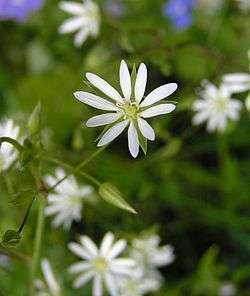Stellaria
| Stellaria | |
|---|---|
 | |
| Greater stitchwort, Stellaria holostea | |
| Scientific classification | |
| Kingdom: | Plantae |
| (unranked): | Angiosperms |
| (unranked): | Eudicots |
| (unranked): | Core eudicots |
| Order: | Caryophyllales |
| Family: | Caryophyllaceae |
| Genus: | Stellaria L. |
Stellaria is a genus of about 90-120 species flowering plants in the family Caryophyllaceae, with a cosmopolitan distribution. Common names include starwort,[1] stitchwort and chickweed.
Description
Stellaria species are relatively small herbs with simple opposite leaves. It produces small flowers with 5 sepals and 5 white petals each usually deeply cleft, or none at all, all free. Stamens 10 or fewer.[2][3]
Uses
Some species, including Stellaria media which is widely distributed throughout the northern hemisphere, are used as leaf vegetables, often raw in salads. This is a favored food of finches and many other seed-eating birds.
Chickweeds are used as food plants by the larvae of some Lepidoptera species including Angle Shades, Heart and Dart, Riband Wave, Setaceous Hebrew Character and the Coleophora case-bearers C. coenosipennella (feeds exclusively on Stellaria spp), C. lineolea (recorded on S. graminea), C. lithargyrinella (recorded on S. holostea), C. solitariella (feeds exclusively on S. holostea) and C. striatipennella.
Several closely related plants referred to as chickweed, but which lack the culinary and medicinal properties of plants in the genus Stellaria, include members of the genus Cerastium, of similar in appearance to Stellaria and also in the (Carophyllaceae).
Selected species

|
|
References
- ↑ "Stellaria". Natural Resources Conservation Service PLANTS Database. USDA. Retrieved 1 December 2015.
- ↑ Parnell, J. and Curtis, T. 2012. Webb's An Irish Flora. Cork University Press. ISBN 978-185918-4783
- ↑ Clapham, A.R., Tutin, T.G. and Warburg, E.F. 1968. Excursion Flora of the British Isles. ISBN 0-521-04656-4
Edible and Medicinal Plants of the West, Gregory L. Tilford, ISBN 0-87842-359-1